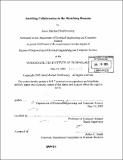| dc.contributor.advisor | Randall Davis. | en_US |
| dc.contributor.author | Smithnosky, Jesse Michael | en_US |
| dc.contributor.other | Massachusetts Institute of Technology. Dept. of Electrical Engineering and Computer Science. | en_US |
| dc.date.accessioned | 2006-07-13T15:18:17Z | |
| dc.date.available | 2006-07-13T15:18:17Z | |
| dc.date.copyright | 2005 | en_US |
| dc.date.issued | 2005 | en_US |
| dc.identifier.uri | http://hdl.handle.net/1721.1/33362 | |
| dc.description | Thesis (M. Eng.)--Massachusetts Institute of Technology, Dept. of Electrical Engineering and Computer Science, 2005. | en_US |
| dc.description | Includes bibliographical references (leaf 47). | en_US |
| dc.description.abstract | Sketching, although deceptively simple and seemingly primitive, is a powerful paradigm for designing and understanding many types of engineering systems. Many problem domains, such as designing electrical circuits, developing flow charts, and modeling simple mechanical devices, rely heavily on the ability to produce sketches efficiently in order to bring out the most salient features. Engineers working in these domains usually rely on pen and paper to generate their design sketches. They do this because more advanced technologies (such as notebook computers) are often unavailable, hard to learn, or cumbersome. It is important for engineers to collaborate with their colleagues while working on their sketches. Unfortunately, collaboration on sketches that exist only as pen and paper often proves to be tedious, requiring a minimum of a fax machine and scanner. Engineers could benefit from a more efficient means of collaboration when dealing with pen and paper sketches. The technology exists to improve the current situation and make pen and paper sketches a more effective medium for collaborative design. This thesis presents an implementation of a system that achieves three goals. First, the system allows two users to collaborate on the production of a sketch in much the same way they would collaborate when composing a document (with one user composing a sketch, then accepting or rejecting the changes of his collaborator). | en_US |
| dc.description.abstract | (cont.) Second, it allows users to watch a collaborator's additions play in real time, like watching a movie. And finally, it links the sketch recognition and simulation software developed by the Design Rationale Group at MIT with a simple pen and paper interface, allowing engineers to run simulations of their design sketches. These goals are achieved by using a commercial pen produced by the Anoto Group that is capable of storing the strokes it draws. In essence, the user creates both a hard and soft copy of the sketch simultaneously, and can share the soft copy with any collaborator. Using this model of production, sketches can be collaboratively generated, edited, and reviewed quickly and easily, all using only a pen, paper, and a standard printer. | en_US |
| dc.description.statementofresponsibility | by Jesse Michael Smithnosky. | en_US |
| dc.format.extent | 47 leaves | en_US |
| dc.format.extent | 1951315 bytes | |
| dc.format.extent | 1953180 bytes | |
| dc.format.mimetype | application/pdf | |
| dc.format.mimetype | application/pdf | |
| dc.language.iso | eng | en_US |
| dc.publisher | Massachusetts Institute of Technology | en_US |
| dc.rights | M.I.T. theses are protected by copyright. They may be viewed from this source for any purpose, but reproduction or distribution in any format is prohibited without written permission. See provided URL for inquiries about permission. | en_US |
| dc.rights.uri | http://dspace.mit.edu/handle/1721.1/7582 | |
| dc.subject | Electrical Engineering and Computer Science. | en_US |
| dc.title | Enabling collaboration in the sketching domain | en_US |
| dc.type | Thesis | en_US |
| dc.description.degree | M.Eng. | en_US |
| dc.contributor.department | Massachusetts Institute of Technology. Department of Electrical Engineering and Computer Science | |
| dc.identifier.oclc | 62458663 | en_US |
